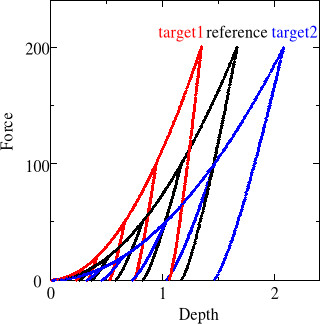Common Dataset for Instrumented Indentation Testing
by K. MIYAHARA

A common dataset for Instrumented Indentation Testing (IIT) is available.
Purpose
- to improve reliability of IIT
- to check analysis programs
- to compare output of different programs with the same input data
- to prepare common data format of IIT
Download
- Document - Background (in Japanese)
- dataset.pdf (updated 2022/04/01)
- Dataset - Generated force-depth curves and info.pdf (in English)
- dataset.zip (updated 2022/04/15)
- Reporting sheet - in Excel format (in English)
- result.xlsx (updated 2022/05/26)
Old dataset
How to use
- This dataset contains force-depth curves of a reference specimen and two other specimens (target1 and target2).
- First, please use curves of the reference specimen to calibrate frame compliance and the area function of the indenter.
- Secondly, please calculate Young's modulus and indentation hardness for each specimen.
- Please send output result to the dataset creator. An Excel sheet is avilable, but any form can be accepted.
- Statistical report will be sent to senders once enough number of results are obtained. The name of senders will be hidden in the report.
FAQ (Frequently Asked Questions)
- Why is such a dataset necessary?
- An indentation tester obtains force-depth curves and the obtained curves are normally analyzed by the tester itself only. This open dataset is created for testing analyzing programs and comparing output of different programs.
- Are force-depth curves in the dataset obtained experimentally?
- No, all curves are generated by a simple model.
- What effect is considered in the model?
- Not-ideal shape of indenter, frame comliance, and some noises are involved.
- How are the material properties? What about testing force?
- Please refer to the document (info.pdf) in dataset.zip.
- Which file format is used?
- The curves are in CSV format and different versions of unit and column position are available.
- Which analysis method should I use for the dataset?
- Please use your normal analysis method for instrumented indentation testing, such as ISO14577.
Presentation PDF
- (2022/03/24) Proposal of round robin analysis for instrumented indentation testing (in Japanese)
Links

